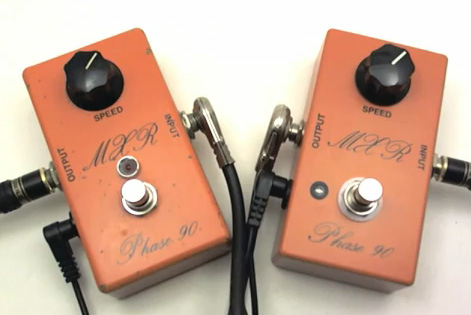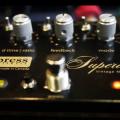 The following post is a guest post by Joshua Zalegowski. If you are interested in guest posting, please contact me!
The following post is a guest post by Joshua Zalegowski. If you are interested in guest posting, please contact me!
MXR Phase 90
Over the years I have seen over a dozen different variations of MXR’s famed Phase 90 phaser pedal. The most common request was to replicate the tone of the original “*script logo*” Phase 90 from the early 1970s. That specific model had set the bar high and was highly sought after. Over the years the Phase 90 had gone through many changes and recently MXR decided to reproduce the original design. MXR’s CSP026- better known as the *’74 Vintage Phase 90*- appears to be a nearly identical copy of the original vintage model. The construction techniques are entirely different from MXR’s other current Phase 90 models which use PCB-mounted switches and jacks. MXR states that this model has a hand-wired board which is not something you’ll find in most mass-produced pedals. This new model continues to use the same style jacks, switch, potentiometer value, and even circuit board of the original. Since we know that the reissue is basically a clone of the original the question is how does the original pedal with aging components compare to the modern day replica.
[iframe_loader width=”425″ height=”344″ frameborder=”0″ longdesc=”” marginheight=”0″ marginwidth=”0″ name=” click_words=”” click_url=”” scrolling=”auto” src=”http://www.youtube.com/embed/vir1VhEEvGI”]
The video posted shows an original MXR Phase 90 from the earlier years of production on the left and the* ’74 Vintage Phase 90* reissue on the right. Both pedals had a DC adapter jack, true bypass switch, and an LED installed. These modifications do not change the tone of the pedal when activated and in no way would skew the results of this comparison. I’d also like to preface this by saying that you should always trust your ears. If one sounds better, brighter, warmer, clearer, or just makes you want to play then by all means that’s what you should purchase. Give both pedals a listen right now if you haven’t done so already and continue on as I discuss my take on the differences.
My first impression was that the reissue was a bit clearer in the high end of the audio spectrum. If one were to describe the vintage model as more organic and natural I would absolutely agree. The rise and fall of the sweep varied slightly between the two pedals; the vintage model having a bit more “swagger” than its reissue counterpart. The overall differences were subtle and I would have a hard time picking a preference.
The Differences Explained:
I mentioned that the reissue is nearly an exact clone of the original and I meant it. While the circuit boards appear to be the same there are two key differences with the components used on them: 1. The original uses carbon composition resistors while the reissue uses precision metal film resistors. Carbon composition resistors are often attributed to being a mythical source of tone in vintage amps. In this application it’s more likely that the loose tolerances of carbon composition resistors paired with forty years of degradation caused their resistance to drift a bit from their original value and thus change the tone.
2. The reissue claims handmatched FETs while the originals were either not matched closely or neighboring components drifted over the years. If the FETs were not closely matched to one another then the sweep would not be smooth and linear. This would explain the asymmetrical “swagger” heard in the video when demonstrating the original model.
The *’74 Vintage Phase 90* reissue is far more accurate to the original than other Phase 90 pedals made by MXR. Unfortunately it seems MXR stuck to the vintage theme and left out true bypass, an LED, and even a DC adapter jack! For information about the modifications pictured above and other Phase 90 mods please check out my website: FXdoctor for pedal modifications
The model used for comparison purposes: MXR CSP026 Vintage 1974 Phase 90
-Joshua Z.
FXdoctor
About the author: Joshua Zalegowski is the owner/operator of FXdoctor located in Boston, MA. For more information about FXdoctor, please visit their website and check out their Facebook page. Additionally, please view the FXdoctor interview.


